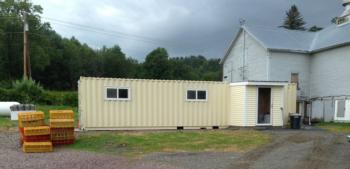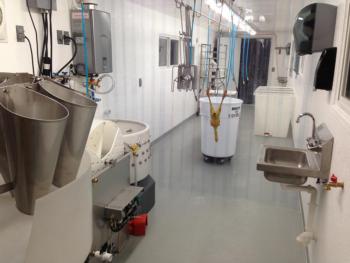Poultry Processing: Plant in a Box
The following was the feature in of Niche Meat Processor Assistance Network (NMPAN) Update #60, written by Kathryn Quanbeck, NMPAN Program Manager, and is re-printed with their permission.
NMPAN presented a webinar Plant in a Box: A Solution for USDA Inspected Poultry Processing, February 2016.
Plant in a Box: A Solution for USDA-Inspected Poultry Processing?
David Schafer, owner and founder of Featherman Equipment and NMPAN member, spends a lot of time thinking about small-scale poultry processing. “Having raised, butchered and sold pastured poultry since 1994” he knows the “benefits and the bottlenecks of a poultry enterprise.” While much of the equipment sold by Featherman is geared towards very small-scale operations, David has been working on a solution for USDA-inspected processing for quite some time now (we reported on the project in 2013). The model is called “Plant in a Box” and aims to be a turnkey answer for those looking to process chickens, turkeys and other poultry under USDA-inspection.

The Plant in a Box unit utilizes a recycled shipping container. 40’ long by 8’ wide and 8’ or 9’ high (“high cubes” as they are often called). The unit comes ready to connect to water and sewer with all the required equipment in it for approximately $80,000. A site pad, water, power, and a plan for effluent are not included and must be provided on site.
With a crew of three trained people, David estimates you could process about 500 birds per day. “Say you process 500 birds per day, 100 days out of the year. That’s 50,000 birds per year. At the Midwest price of $3/bird, that is a gross of $150,000 per year. Even at half that volume your payback is less than 3 years.”
The Plant in a Box unit takes a chicken from “crate to chill tank”: no storage is included in the space or throughput estimates. David recommends moving chilled poultry with large totes that can be moved with a forklift and wheeled into a separate packaging and storage area or back into the (cleaned) evisceration room for drying and packaging. A video of the Plant in a Box prototype can be seen here.
The first Plant in a Box prototype started operations in 2013 at Maple Wind Farm (MWF) in Richmond, VT. “The ‘plug and play’ aspect was really nice,” says John Smith, poultry manager at MWF. “It was delivered and we were operating under inspection within a week or two.” MWF worked closely with David to fine tune the unit before arrival as this is the first one in operation.

MWF would like to build upon the Plant in a Box infrastructure and expand their operations to have a separate space for cutting up and packaging birds. Right now, they slaughter in the morning, clean the evisceration room at lunch, and then cut and package in that same room after lunch. It works, but involves hauling a lot of things in and out, which isn’t very efficient.
As with many meat processing facilities, MWF’s biggest challenge is labor: how to keep skilled staff busy year round. “We’re a three season facility, but we are trying to move in the direction of keeping people busy year round so we can keep them on staff,” says John. MWF is their own largest customer, raising and marketing about 75% of the birds they process. They fill in the rest of their processing days with birds from other producers, charging $5/chicken and $10/turkey for processing.
John believes they need to process at least 20,000 - 25,000 birds per year to cover operating costs. MWF tries to process as many birds as possible on processing days. “Setup and cleanup accounts for a significant portion of our time and this takes the same amount of time no matter how many birds we do.” Overall, John says the Plant in a Box unit has been a great move for them and he would recommend it to others.
David has a strong vision for expanding the Plant in a Box concept across the country. He would like to see multiple units in operation, able to share resources, tips and tricks, and leverage their collective experience.
For more information about Plant in a Box, visit Featherman Equipment.